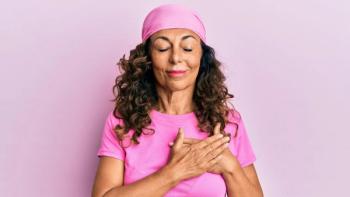
ASCO: PET-driven therapy for aggressive lymphoma
CURE invited Diane Gambill, PhD, a CURE advisory board member, to share her thoughts on advancements in lymphoma highlighted at the 2014 annual meeting of the American Society of Clinical Oncology.Patients 60 years old and younger who have high-risk aggressive lymphoma (diffuse large B-cell lymphoma [DLBCL]) might not need a transplantation according to results of a phase 2 trial announced at the annual meeting of the American Society for Clinical Oncology.The trial (LNH 2007-3B), presented by the French GELA/LYSA group, assessed 222 patients' response to chemoimmunotherapy, which was evaluated using positron emission tomography (PET) scans after two (PET2) and four (PET4) cycles of treatment. PET scanning results were used to drive the decision to continue chemoimmunotherapy versus autologous stem cell transplantation (ASCT) after four cycles of treatment. Previously, PET2-negative results had been associated with improved outcomes for patients with high-risk DLBCL, so investigators of the trial thought some patients might not need an ASCT. Patients on the study were randomized to receive chemoimmunotherapy with Rituxan/CHOP14 or Rituxan/ACVBP14. As expected, patients on the Rituxan/ACVBP14 regimen had a higher rate of serious toxicities, notably febrile neutropenia, infection and mucositis than patients on the Rituxan/CHOP14 regimen. Despite the difference in toxicities, the number of patients who withdrew from the trial early was similar between the arms (six on the Rituxan/ACVBP14 regimen and five on the Rituxan/CHOP14).Based on PET2 and PET4 scan results, there were three different consolidation treatment plans: • Patients with a PET4-positive result indicated that active disease was present and the patient was taken off study to receive salvage chemotherapy. Fewer patients on the Rituxan/ACVBP14 regimen received salvage therapy than on the Rituxan/CHOP14 regimen (27 percent and 39 percent, respectively). This difference was statistically meaningful and is consistent with the response advantage seen in lower-risk DLBCL.• Patients with a PET4-negative result, meaning they had a complete response to chemoimmunotherapy, were treated according to their PET2 scan result. o Patients with PET4-negative but PET2-positive scans were treated with an ASCT, which resulted in a similar number of patients for each regimen: 41 percent for Rituxan/ACVBP versus 33 percent for Rituxan/CHOP. o Patients who had both PET2- and PET4-negative scans received further chemoimmunotherapy and the numbers were similar for both regimens. Overall, 25 percent of the patients in this study were eligible for this approach, sparing them from ASCT.So, what does this trial mean for patients in the U.S.? First, this phase 2 result is intriguing but requires further investigation before it is ready for the clinic. Second, one of the drugs in the ACVBP regimen is not available in the U.S.; however, despite the differences in numbers of patients with PET4-positive scans between the regimens, progression-free survival and overall survival were not statistically different. The investigators suggested that matching the PET response to an appropriate consolidation therapy might be responsible for the similar survival outcomes. Finally, using PET to assess response to initial therapy is currently the standard for DLBCL; but some worry about the potential risks of PET scans, notably false positives and second malignancies, particularly in a younger population (those 60 years old and younger). In the case of high-risk DLBCL, biopsies are needed to confirm PET-positivity, and the benefits of PET outweigh the risks given the potential for long-term disease control. The GELA/LYSA investigators have started a phase 3 trial, called GAINED, to confirm these results.




